Amplifiers in Biomedical Engineering: A Review from Application Perspectives
Abstract
:1. Introduction
2. Biomedical Devices from an Engineering Perspective
3. Biomedical Amplifiers and Various Designs
4. Biomedical Amplifiers from IC and Layout Perspectives
5. Biomedical Applications from the Measurement Perspective
6. Conclusions
Author Contributions
Funding
Institutional Review Board Statement
Informed Consent Statement
Data Availability Statement
Conflicts of Interest
References
- Singh, W.; Deb, S.; Bahubalindruni, P. Low-Noise Energy Efficient Readout Front-End for Wearable Continuous Blood Pressure Monitoring Systems. IEEE Trans. Consum. Electron. 2020, 66, 318–326. [Google Scholar] [CrossRef]
- Neihart, N.; Harrison, R. Micropower circuits for bidirectional wireless telemetry in neural recording applications. IEEE Trans. Biomed. Eng. 2005, 52, 1950–1959. [Google Scholar] [CrossRef] [PubMed]
- Liu, C.; Yang, X.M.; Guo, Y.X.; Liu, X. Design of an integrated on-chip implantable antenna for a neuromicrosystem. In Proceedings of the 2016 IEEE MTT-S International Microwave Workshop Series on Advanced Materials and Processes for RF and THz Applications (IMWS-AMP), Chengdu, China, 20–22 July 2016; pp. 1–3. [Google Scholar] [CrossRef]
- Yakovlev, A.; Kim, S.; Poon, A. Implantable biomedical devices: Wireless powering and communication. IEEE Commun. Mag. 2012, 50, 152–159. [Google Scholar] [CrossRef]
- Xia, Y.; Fan, Y. Security Analysis of Sports Injury Medical System Based on Internet of Health Things Technology. IEEE Access 2020, 8, 211358–211370. [Google Scholar] [CrossRef]
- Chiu, C.Y.; Zhang, Z.C.; Lin, T.H. Design of a 0.6-V, 429-MHz FSK Transceiver Using Q-Enhanced and Direct Power Transfer Techniques in 90-nm CMOS. IEEE J. Solid-State Circuits 2020, 55, 3024–3035. [Google Scholar] [CrossRef]
- Zhang, F.; Miyahara, Y.; Otis, B.P. Design of a 300-mV 2.4-GHz Receiver Using Transformer-Coupled Techniques. IEEE J. Solid-State Circuits 2013, 48, 3190–3205. [Google Scholar] [CrossRef]
- Jiang, D.; Wu, Y.; Demosthenous, A. Hand Gesture Recognition Using Three-Dimensional Electrical Impedance Tomography. IEEE Trans. Circuits Syst. II Express Briefs 2020, 67, 1554–1558. [Google Scholar] [CrossRef]
- Surakitbovorn, K.; Rivas-Davila, J.M. Modular ON/OFF and Phase-Shifting for High-Speed Radio Frequency Power Modulation. IEEE Open J. Power Electron. 2020, 1, 393–406. [Google Scholar] [CrossRef]
- Pavelić, L.; Lacković, I.; Mihić, M.S.; Prlić, I. SiPM-Based Detector for High-Resolution Measurements in Pulsed Radiation Fields. IEEE Trans. Instrum. Meas. 2021, 70, 1–8. [Google Scholar] [CrossRef]
- Byzova, A.; Hekmatmanesh, A.; Roozbahani, H.; Handroos, H.; Hakansson, N.; Lankarani, H.M. Real-Time Human Body and Brain Monitoring During Horseback Riding Simulator by Means of Inertial Motion Capture and EEG Systems. IEEE Access 2020, 8, 162163–162171. [Google Scholar] [CrossRef]
- Ratametha, C.; Tepwimonpetkun, S.; Wattanapanitch, W. A 2.64-μW 71-dB SNDR Discrete-Time Signal-Folding Amplifier for Reducing ADC’s Resolution Requirement in Wearable ECG Acquisition Systems. IEEE Trans. Biomed. Circuits Syst. 2020, 14, 48–64. [Google Scholar] [CrossRef]
- Song, H.S.; Lee, S.H.; Ghergherehchi, M.; Kim, H.S.; Lee, J.C.; Oh, S.Y.; Hur, M.G.; Chai, J.S. Modular 20 kW, 83.2-MHz Solid-State RF Amplifier for a 10-MeV Cyclotron. IEEE Trans. Nucl. Sci. 2019, 66, 1924–1930. [Google Scholar] [CrossRef]
- Al-Atawi, A.A.; Khan, F.; Kim, C.G. Application and Challenges of IoT Healthcare System in COVID-19. Sensors 2022, 22, 7304. [Google Scholar] [CrossRef] [PubMed]
- Miglani, R.; Malhotra, J.S.; Majumdar, A.K.; Tubbal, F.; Raad, R. Multi-Hop Relay Based Free Space Optical Communication Link for Delivering Medical Services in Remote Areas. IEEE Photonics J. 2020, 12, 1–21. [Google Scholar] [CrossRef]
- Lee, S.Y.; Tsou, C.; Liao, Z.X.; Cheng, P.H.; Huang, P.W.; Lee, H.Y.; Lin, C.C.; Shieh, G.S. A Programmable EEG Monitoring SoC With Optical and Electrical Stimulation for Epilepsy Control. IEEE Access 2020, 8, 92196–92211. [Google Scholar] [CrossRef]
- Koo, N.; Cho, S. A 24.8-μW Biopotential Amplifier Tolerant to 15-VPP Common-Mode Interference for Two-Electrode ECG Recording in 180 nm CMOS. IEEE J. Solid-State Circuits 2021, 56, 591–600. [Google Scholar] [CrossRef]
- Cochran, Z.; Ytterdal, T.; Madan, A.; Rizkalla, M. High Speed Terahertz Devices via Emerging Hybrid GNRFET/Josephson Junction Technologies. IEEE Trans. Appl. Supercond. 2020, 30, 1–11. [Google Scholar] [CrossRef]
- Kim, J.; Ko, H. Self-Biased Ultralow Power Current-Reused Neural Amplifier with on-Chip Analog Spike Detections. IEEE Access 2019, 7, 109792–109803. [Google Scholar] [CrossRef]
- Different Parts of Body Suitable for Implanted Devices. Available online: http://technologyandsociety.org/implantable-technology/ (accessed on 25 January 2022).
- Karimi-Bidhendi, A.; Malekzadeh-Arasteh, O.; Lee, M.C.; McCrimmon, C.M.; Wang, P.T.; Mahajan, A.; Liu, C.Y.; Nenadic, Z.; Do, A.H.; Heydari, P. CMOS Ultralow Power Brain Signal Acquisition Front-Ends: Design and Human Testing. IEEE Trans. Biomed. Circuits Syst. 2017, 11, 1111–1122. [Google Scholar] [CrossRef]
- Hannan, M.A.; Hussein, H.A.; Mutashar, S.; Samad, S.A.; Hussain, A. Automatic Frequency Controller for Power Amplifiers Used in Bio-Implanted Applications: Issues and Challenges. Sensors 2014, 14, 23843. [Google Scholar] [CrossRef] [Green Version]
- Kouhalvandi, L.; Matekovits, L.; Peter, I. Magic of 5G Technology and Optimization Methods Applied to Biomedical Devices: A Survey. Appl. Sci. 2022, 12, 7096. [Google Scholar] [CrossRef]
- Liu, X.; Zhu, H.; Zhang, M.; Wu, X.; Richardson, A.G.; Sritharan, S.Y.; Ge, D.; Shu, Y.; Lucas, T.H.; Van der Spiegel, J. A fully integrated wireless sensor-brain interface system to restore finger sensation. In Proceedings of the 2017 IEEE International Symposium on Circuits and Systems (ISCAS), Baltimore, MD, USA, 28–31 May 2017; pp. 1–4. [Google Scholar] [CrossRef]
- Lee, J.; Lee, K.R.; Ha, U.; Kim, J.H.; Lee, K.; Gweon, S.; Jang, J.; Yoo, H.J. A 0.8-V 82.9-μW In-Ear BCI Controller IC With 8.8 PEF EEG Instrumentation Amplifier and Wireless BAN Transceiver. IEEE J. Solid-State Circuits 2019, 54, 1185–1195. [Google Scholar] [CrossRef]
- Stanslaski, S.; Herron, J.; Chouinard, T.; Bourget, D.; Isaacson, B.; Kremen, V.; Opri, E.; Drew, W.; Brinkmann, B.H.; Gunduz, A.; et al. A Chronically Implantable Neural Coprocessor for Investigating the Treatment of Neurological Disorders. IEEE Trans. Biomed. Circuits Syst. 2018, 12, 1230–1245. [Google Scholar] [CrossRef]
- Huang, J.; Laiwalla, F.; Lee, J.; Cui, L.; Leung, V.; Nurmikko, A.; Mercier, P.P. A 0.01-mm2 Mostly Digital Capacitor-Less AFE for Distributed Autonomous Neural Sensor Nodes. IEEE Solid-State Circuits Lett. 2018, 1, 162–165. [Google Scholar] [CrossRef]
- Lyu, L.; Ye, D.; Shi, C.J.R. A 340 nW/Channel 110 dB PSRR Neural Recording Analog Front-End Using Replica-Biasing LNA, Level-Shifter Assisted PGA, and Averaged LFP Servo Loop in 65 nm CMOS. IEEE Trans. Biomed. Circuits Syst. 2020, 14, 811–824. [Google Scholar] [CrossRef]
- Lin, Y.P.; Yeh, C.Y.; Huang, P.Y.; Wang, Z.Y.; Cheng, H.H.; Li, Y.T.; Chuang, C.F.; Huang, P.C.; Tang, K.T.; Ma, H.P.; et al. A Battery-Less, Implantable Neuro-Electronic Interface for Studying the Mechanisms of Deep Brain Stimulation in Rat Models. IEEE Trans. Biomed. Circuits Syst. 2016, 10, 98–112. [Google Scholar] [CrossRef]
- Cruz, H.; Huang, H.Y.; Lee, S.Y.; Luo, C.H. A 1.3 mW low-IF, current-reuse, and current-bleeding RF front-end for the MICS band with sensitivity of -97 dbm. IEEE Trans. Circuits Syst. I Regul. Pap. 2015, 62, 1627–1636. [Google Scholar] [CrossRef]
- Zamani, M.; Rezaeiyan, Y.; Huynh, H.A.; Ronchini, M.; Farkhani, H.; Moradi, F. A 2.3-μW Capacitively Coupled Chopper-Stabilized Neural Amplifier With Input Impedance of 6.7 GΩ. IEEE Solid-State Circuits Lett. 2021, 4, 133–136. [Google Scholar] [CrossRef]
- Lee, S.Y.; Cheng, P.H.; Tsou, C.F.; Lin, C.C.; Shieh, G.S. A 2.4 GHz ISM Band OOK Transceiver With High Energy Efficiency for Biomedical Implantable Applications. IEEE Trans. Biomed. Circuits Syst. 2020, 14, 113–124. [Google Scholar] [CrossRef]
- Ghanad, M.A.; Green, M.M.; Dehollain, C. A 30 μW Remotely Powered Local Temperature Monitoring Implantable System. IEEE Trans. Biomed. Circuits Syst. 2017, 11, 54–63. [Google Scholar] [CrossRef]
- Ahmadi, M.M.; Ghandi, S. A Class-E Power Amplifier With Wideband FSK Modulation for Inductive Power and Data Transmission to Medical Implants. IEEE Sens. J. 2018, 18, 7242–7252. [Google Scholar] [CrossRef]
- Valente, V.; Eder, C.; Donaldson, N.; Demosthenous, A. A High-Power CMOS Class-D Amplifier for Inductive-Link Medical Transmitters. IEEE Trans. Power Electron. 2015, 30, 4477–4488. [Google Scholar] [CrossRef]
- Wang, S.; Garakoui, S.K.; Chun, H.; Salinas, D.G.; Sijbers, W.; Putzeys, J.; Martens, E.; Craninckx, J.; Van Helleputte, N.; Lopez, C.M. A Compact Quad-Shank CMOS Neural Probe with 5120 Addressable Recording Sites and 384 Fully Differential Parallel Channels. IEEE Trans. Biomed. Circuits Syst. 2019, 13, 1625–1634. [Google Scholar] [CrossRef]
- Hansen, S.; Bredendiek, C.; Briese, G.; Pohl, N. A Compact Harmonic Radar System With Active Tags at 61/122 GHz ISM Band in SiGe BiCMOS for Precise Localization. IEEE Trans. Microw. Theory Tech. 2021, 69, 906–915. [Google Scholar] [CrossRef]
- Laurila, M.M.; Matsui, H.; Shiwaku, R.; Peltokangas, M.; Verho, J.; Montero, K.L.; Sekine, T.; Vehkaoja, A.; Oksala, N.; Tokito, S.; et al. A Fully Printed Ultra-Thin Charge Amplifier for On-Skin Biosignal Measurements. IEEE J. Electron Devices Soc. 2019, 7, 566–574. [Google Scholar] [CrossRef]
- Mirbozorgi, S.A.; Bahrami, H.; Sawan, M.; Rusch, L.A.; Gosselin, B. A Single-Chip Full-Duplex High Speed Transceiver for Multi-Site Stimulating and Recording Neural Implants. IEEE Trans. Biomed. Circuits Syst. 2016, 10, 643–653. [Google Scholar] [CrossRef]
- Jia, Y.; Guler, U.; Lai, Y.P.; Gong, Y.; Weber, A.; Li, W.; Ghovanloo, M. A Trimodal Wireless Implantable Neural Interface System-on-Chip. IEEE Trans. Biomed. Circuits Syst. 2020, 14, 1207–1217. [Google Scholar] [CrossRef]
- Ng, K.A.; Yuan, C.; Rusly, A.; Do, A.T.; Zhao, B.; Liu, S.C.; Peh, W.Y.X.; Thow, X.Y.; Voges, K.; Lee, S.; et al. A Wireless Multi-Channel Peripheral Nerve Signal Acquisition System-on-Chip. IEEE J. Solid-State Circuits 2019, 54, 2266–2280. [Google Scholar] [CrossRef]
- Sutardja, C.; Rabaey, J.M. Isolator-Less Near-Field RFID Reader for Sub-Cranial Powering/Data Link of Millimeter-Sized Implants. IEEE J. Solid-State Circuits 2018, 53, 2032–2042. [Google Scholar] [CrossRef]
- Lin, J.Y.; Chen, H.C.; Yen, M.Y. Sensor/Antenna Interface IC for Implantable Biomedical Monitoring System. IEEE Trans. Microw. Theory Tech. 2018, 66, 1660–1667. [Google Scholar] [CrossRef]
- Copani, T.; Min, S.; Shashidharan, S.; Chakraborty, S.; Stevens, M.; Kiaei, S.; Bakkaloglu, B. A CMOS Low-Power Transceiver With Reconfigurable Antenna Interface for Medical Implant Applications. IEEE Trans. Microw. Theory Tech. 2011, 59, 1369–1378. [Google Scholar] [CrossRef]
- Yang, C.L.; Tsai, C.L.; Cheng, K.T.; Chen, S.H. Low-Invasive Implantable Devices of Low-Power Consumption Using High-Efficiency Antennas for Cloud Health Care. IEEE J. Emerg. Sel. Top. Circuits Syst. 2012, 2, 14–23. [Google Scholar] [CrossRef]
- Abdulmalek, S.; Nasir, A.; Jabbar, W.A.; Almuhaya, M.A.M.; Bairagi, A.K.; Khan, M.A.M.; Kee, S.H. IoT-Based Healthcare-Monitoring System towards Improving Quality of Life: A Review. Healthcare 2022, 10, 1993. [Google Scholar] [CrossRef]
- Park, B.; Kwon, K. 2.4-GHz Bluetooth Low Energy Receiver Employing New Quadrature Low-Noise Amplifier for Low-Power Low-Voltage IoT Applications. IEEE Trans. Microw. Theory Tech. 2021, 69, 1887–1895. [Google Scholar] [CrossRef]
- Han, Z.; Xu, J.; Yang, C.; Wang, N.; Li, Z.; Cui, Y.; Jian, X. A High Sensitivity 20-MHz Endoscopic Transducer With Integrated Miniature Amplifier. IEEE Access 2020, 8, 109241–109248. [Google Scholar] [CrossRef]
- Lee, C.J.; Song, J.I. A Chopper Stabilized Current-Feedback Instrumentation Amplifier for EEG Acquisition Applications. IEEE Access 2019, 7, 11565–11569. [Google Scholar] [CrossRef]
- Chen, Y.; Basu, A.; Liu, L.; Zou, X.; Rajkumar, R.; Dawe, G.S.; Je, M. A Digitally Assisted, Signal Folding Neural Recording Amplifier. IEEE Trans. Biomed. Circuits Syst. 2014, 8, 528–542. [Google Scholar] [CrossRef]
- Zhou, Z. A Front-End Amplifier With Current Compensation Feedback Input Impedance Booster for Neural Signal Applications. IEEE Access 2020, 8, 178055–178062. [Google Scholar] [CrossRef]
- Luo, D.; Zhang, M.; Wang, Z. A Low-Noise Chopper Amplifier Designed for Multi-Channel Neural Signal Acquisition. IEEE J. Solid-State Circuits 2019, 54, 2255–2265. [Google Scholar] [CrossRef]
- Tasneem, N.T.; Pullano, S.A.; Critello, C.D.; Fiorillo, A.S.; Mahbub, I. A Low-Power On-Chip ECG Monitoring System Based on MWCNT/PDMS Dry Electrodes. IEEE Sens. J. 2020, 20, 12799–12806. [Google Scholar] [CrossRef]
- Song, S.; Rooijakkers, M.; Harpe, P.; Rabotti, C.; Mischi, M.; van Roermund, A.H.M.; Cantatore, E. A Low-Voltage Chopper-Stabilized Amplifier for Fetal ECG Monitoring With a 1.41 Power Efficiency Factor. IEEE Trans. Biomed. Circuits Syst. 2015, 9, 237–247. [Google Scholar] [CrossRef] [Green Version]
- Tang, T.; Yan, L.; Park, J.H.; Wu, H.; Zhang, L.; Li, J.; Dong, Y.; Lee, B.H.Y.; Yoo, J. An Active Concentric Electrode for Concurrent EEG Recording and Body-Coupled Communication (BCC) Data Transmission. IEEE Trans. Biomed. Circuits Syst. 2020, 14, 1253–1262. [Google Scholar] [CrossRef]
- Malekzadeh-Arasteh, O.; Danesh, A.R.; Do, A.H.; Nenadic, Z.; Heydari, P. An Analysis of CMRR Degradation in Multi-Channel Biosignal Recording Systems. IEEE Trans. Circuits Syst. II Express Briefs 2021, 68, 151–155. [Google Scholar] [CrossRef]
- Gao, Z.; Gui, P.; Jordanger, R. An Integrated High-Voltage Low-Distortion Current-Feedback Linear Power Amplifier for Ultrasound Transmitters Using Digital Predistortion and Dynamic Current Biasing Techniques. IEEE Trans. Circuits Syst. II Express Briefs 2014, 61, 373–377. [Google Scholar] [CrossRef]
- Quang, L.D.; Bui, T.T.; Hoang, B.A.; Nhu, C.N.; Thuy, H.T.T.; Jen, C.P.; Duc, T.C. Biological Living Cell in-Flow Detection Based on Microfluidic Chip and Compact Signal Processing Circuit. IEEE Trans. Biomed. Circuits Syst. 2020, 14, 1371–1380. [Google Scholar] [CrossRef] [PubMed]
- Kim, H.; Han, K.; Kim, J.; You, D.; Heo, H.; Kwon, Y.; Kim, C.Y.; Lee, H.D.; Ko, H. Chopper-Stabilized Low-Noise Multipath Operational Amplifier With Dual Ripple Rejection Loops. IEEE Trans. Circuits Syst. II Express Briefs 2020, 67, 2427–2431. [Google Scholar] [CrossRef]
- Hoseini, Z.; Nazari, M.; Lee, K.S.; Chung, H. Current Feedback Instrumentation Amplifier With Built-In Differential Electrode Offset Cancellation Loop for ECG/EEG Sensing Frontend. IEEE Trans. Instrum. Meas. 2021, 70, 1–11. [Google Scholar] [CrossRef]
- Nguyen, M.Q.; Hughes, Z.; Woods, P.; Seo, Y.S.; Rao, S.; Chiao, J.C. Field Distribution Models of Spiral Coil for Misalignment Analysis in Wireless Power Transfer Systems. IEEE Trans. Microw. Theory Tech. 2014, 62, 920–930. [Google Scholar] [CrossRef]
- Kim, H.R.; An, C.H.; Kong, B.S. High-Speed Column Driver IC Having Buffer Amplifier with Embedded Isolation Switch and Compact Adaptive Biasing for Flat-Panel Displays. Electronics 2021, 10, 2309. [Google Scholar] [CrossRef]
- Sajedin, M.; Elfergani, I.; Rodriguez, J.; Abd-Alhameed, R.; Fernandez-Barciela, M.; Violas, M. Ultra-Compact mm-Wave Monolithic IC Doherty Power Amplifier for Mobile Handsets. Electronics 2021, 10, 2131. [Google Scholar] [CrossRef]
- Alonso Rivas, E.; Scandurra, G.; Ciofi, C.; Rodríguez-Morcillo García, C.; Giannetti, R. A Novel Approach for the Design of Fast-Settling Amplifiers for Biosignal Detection. Electronics 2021, 10, 2631. [Google Scholar] [CrossRef]
- Jaikla, W.; Buakhong, U.; Siripongdee, S.; Khateb, F.; Sotner, R.; Silapan, P.; Suwanjan, P.; Chaichana, A. Single Commercially Available IC-Based Electronically Controllable Voltage-Mode First-Order Multifunction Filter with Complete Standard Functions and Low Output Impedance. Sensors 2021, 21, 7376. [Google Scholar] [CrossRef] [PubMed]
- Corbacho, I.; Carrillo, J.M.; Ausín, J.L.; Domínguez, M.Á.; Pérez-Aloe, R.; Duque-Carrillo, J.F. A Fully-Differential CMOS Instrumentation Amplifier for Bioimpedance-Based IoT Medical Devices. J. Low Power Electron. Appl. 2023, 13, 3. [Google Scholar] [CrossRef]
- Simmich, S.; Bahr, A.; Rieger, R. Noise Efficient Integrated Amplifier Designs for Biomedical Applications. Electronics 2021, 10, 1522. [Google Scholar] [CrossRef]
- Cheon, S.I.; Kweon, S.J.; Kim, Y.; Koo, J.; Ha, S.; Je, M. An Impedance Readout IC with Ratio-Based Measurement Techniques for Electrical Impedance Spectroscopy. Sensors 2022, 22, 1563. [Google Scholar] [CrossRef]
- Corbacho, I.; Carrillo, J.M.; Ausín, J.L.; Domínguez, M.Á.; Pérez-Aloe, R.; Duque-Carrillo, J.F. Compact CMOS Wideband Instrumentation Amplifiers for Multi-Frequency Bioimpedance Measurement: A Design Procedure. Electronics 2022, 11, 1668. [Google Scholar] [CrossRef]
- Alimisis, V.; Dimas, C.; Pappas, G.; Sotiriadis, P.P. Analog Realization of Fractional-Order Skin-Electrode Model for Tetrapolar Bio-Impedance Measurements. Technologies 2020, 8, 61. [Google Scholar] [CrossRef]
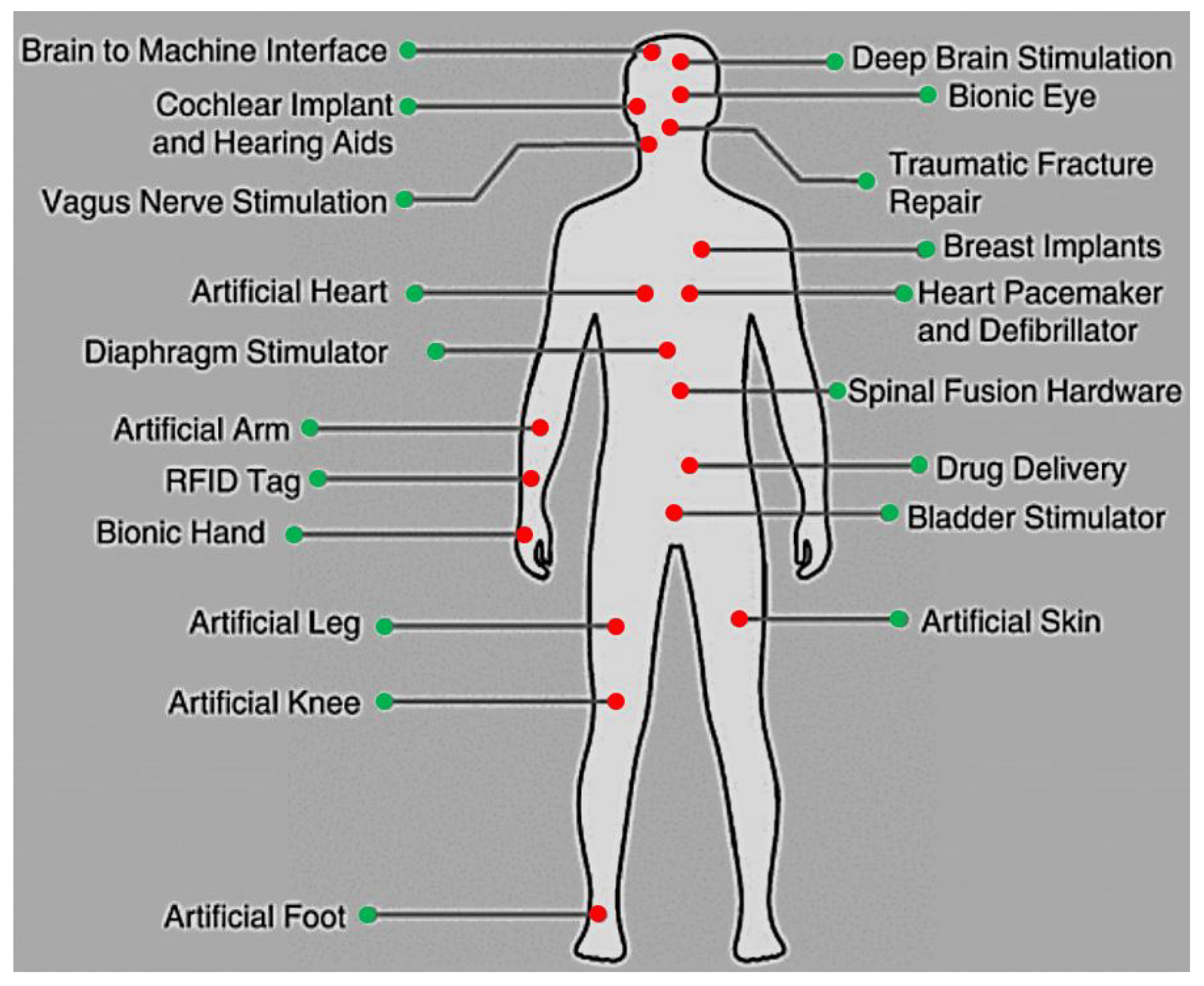
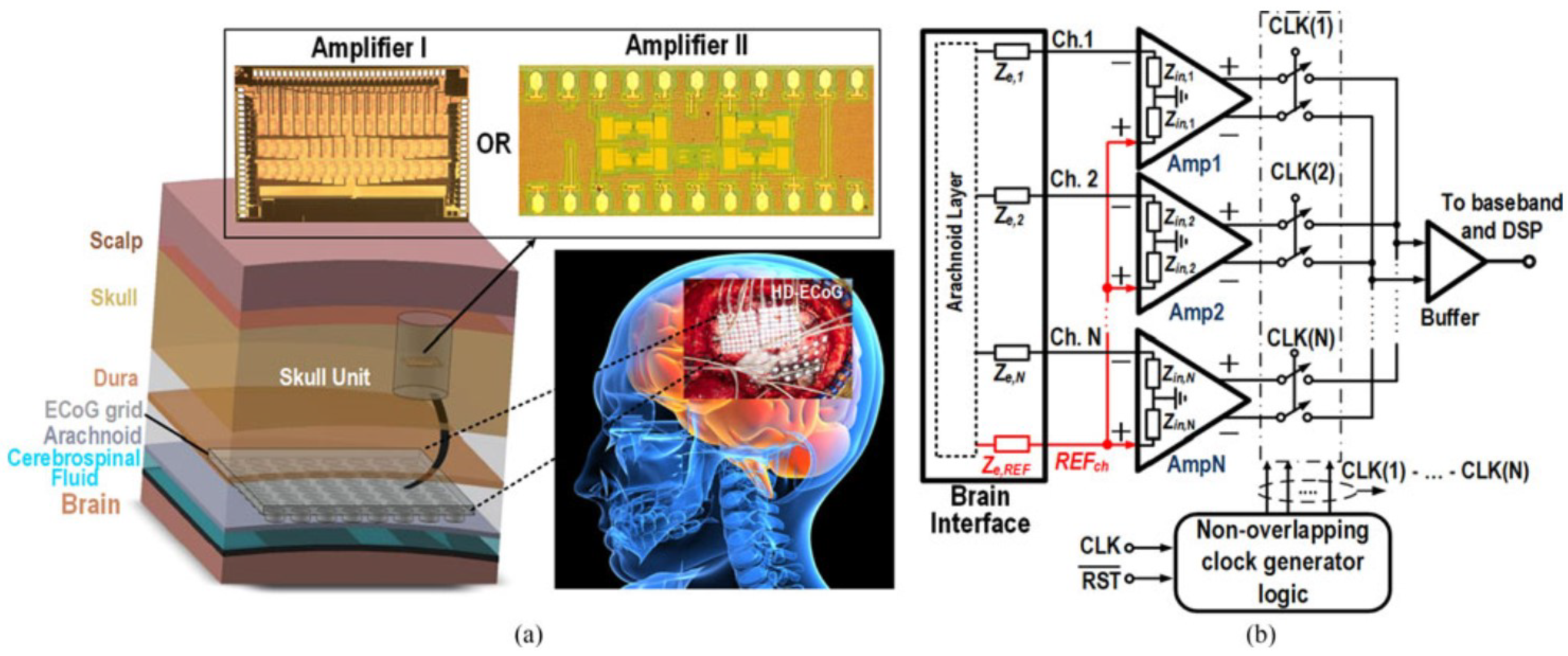
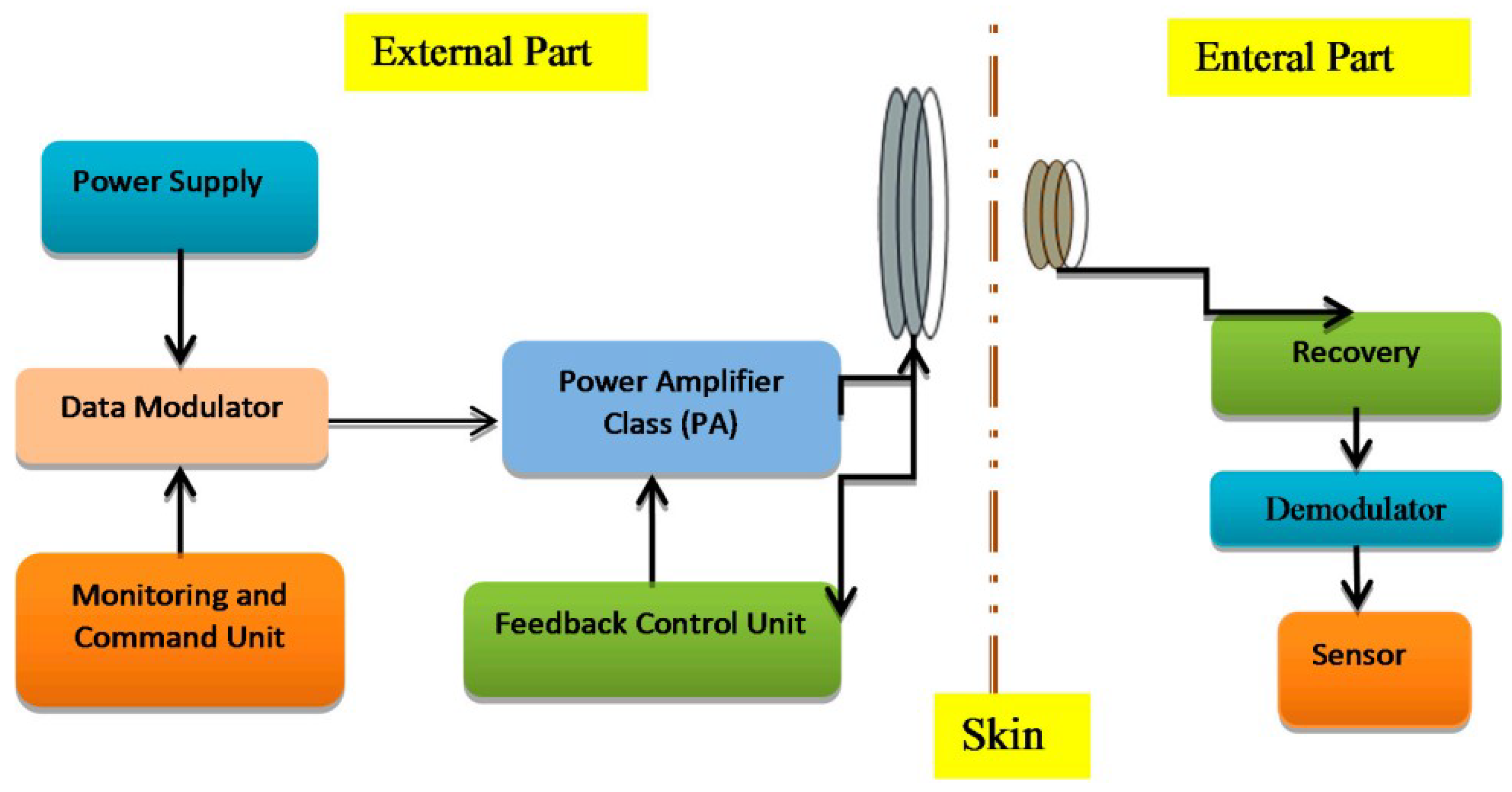
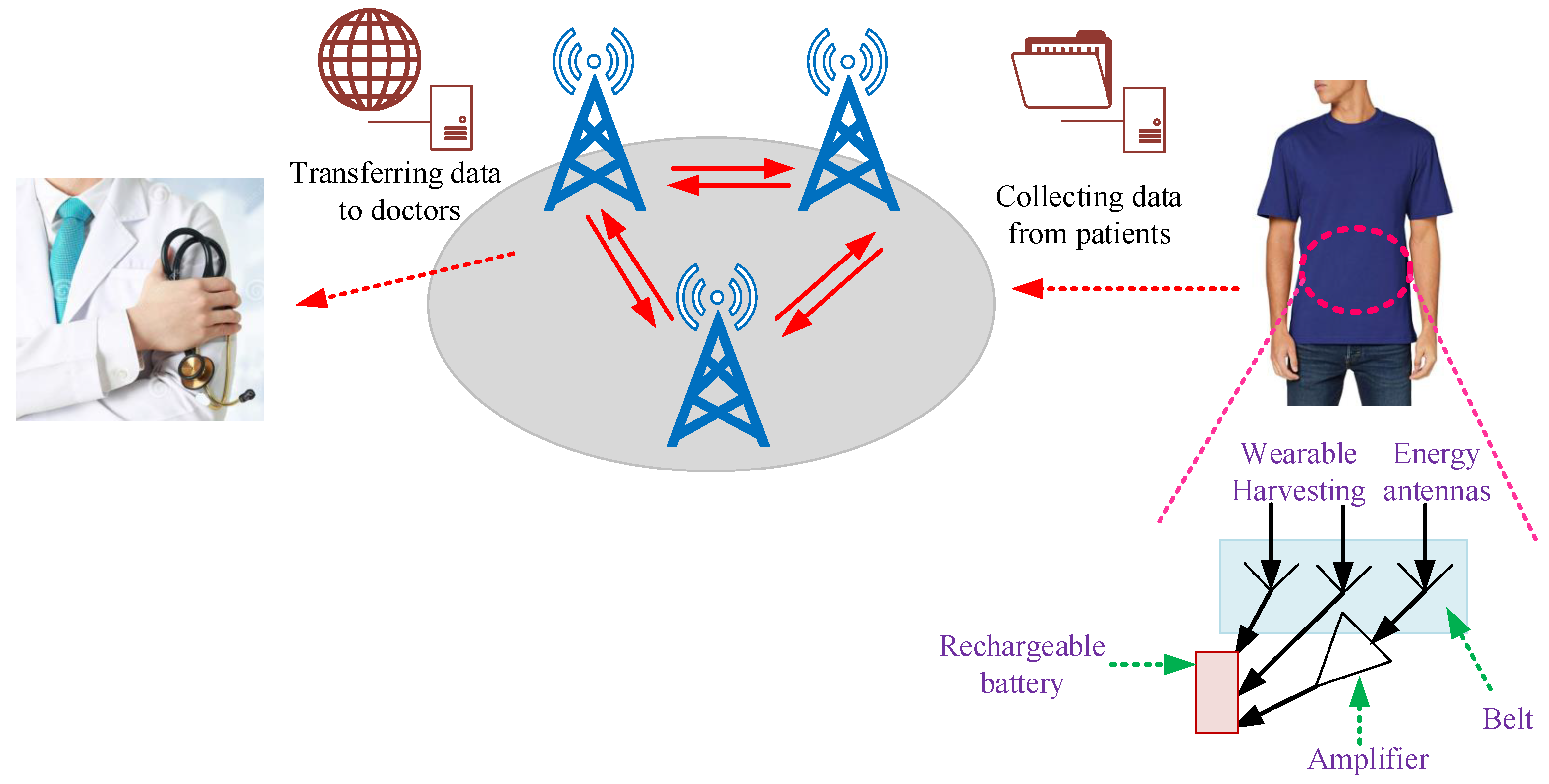
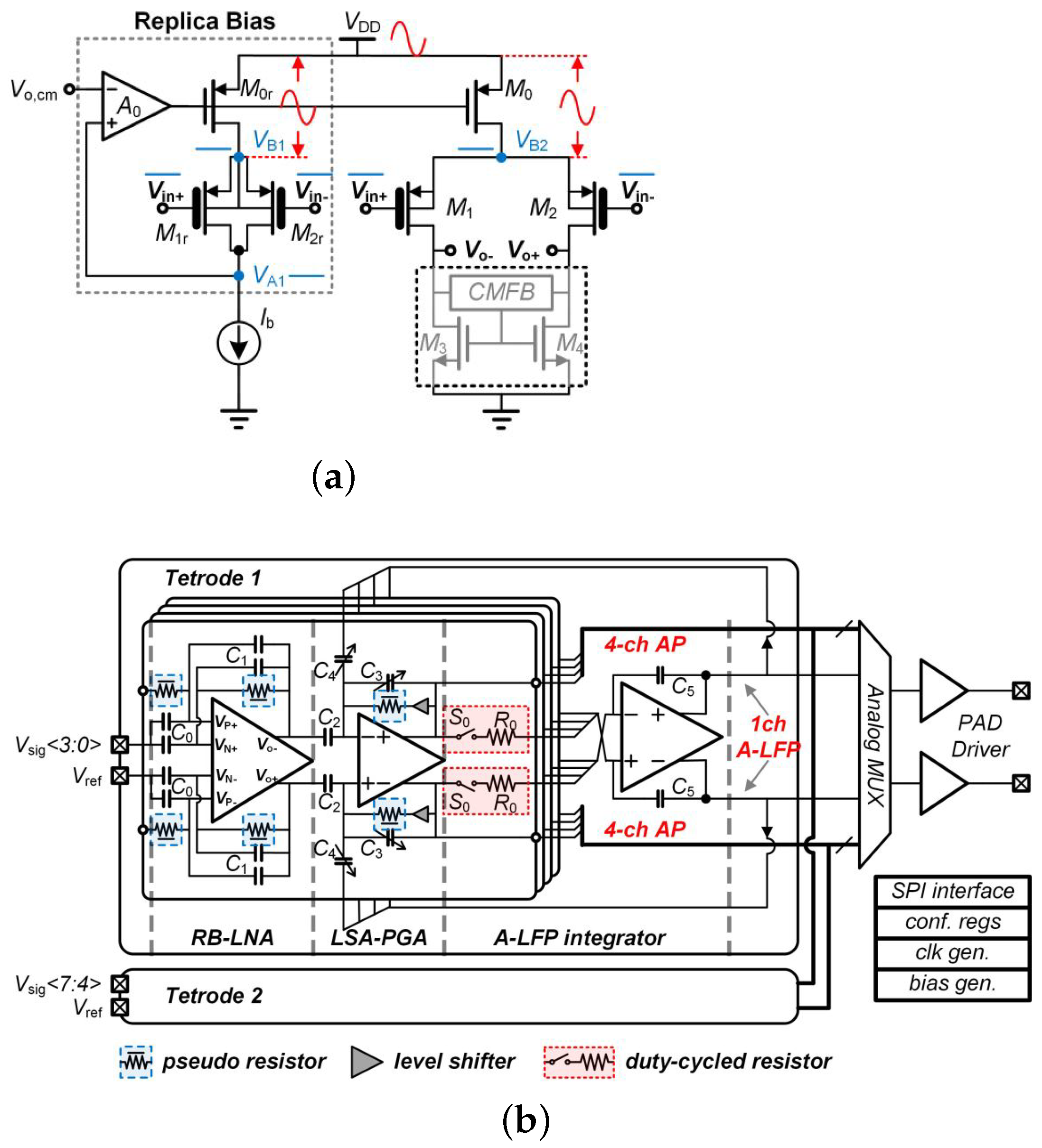
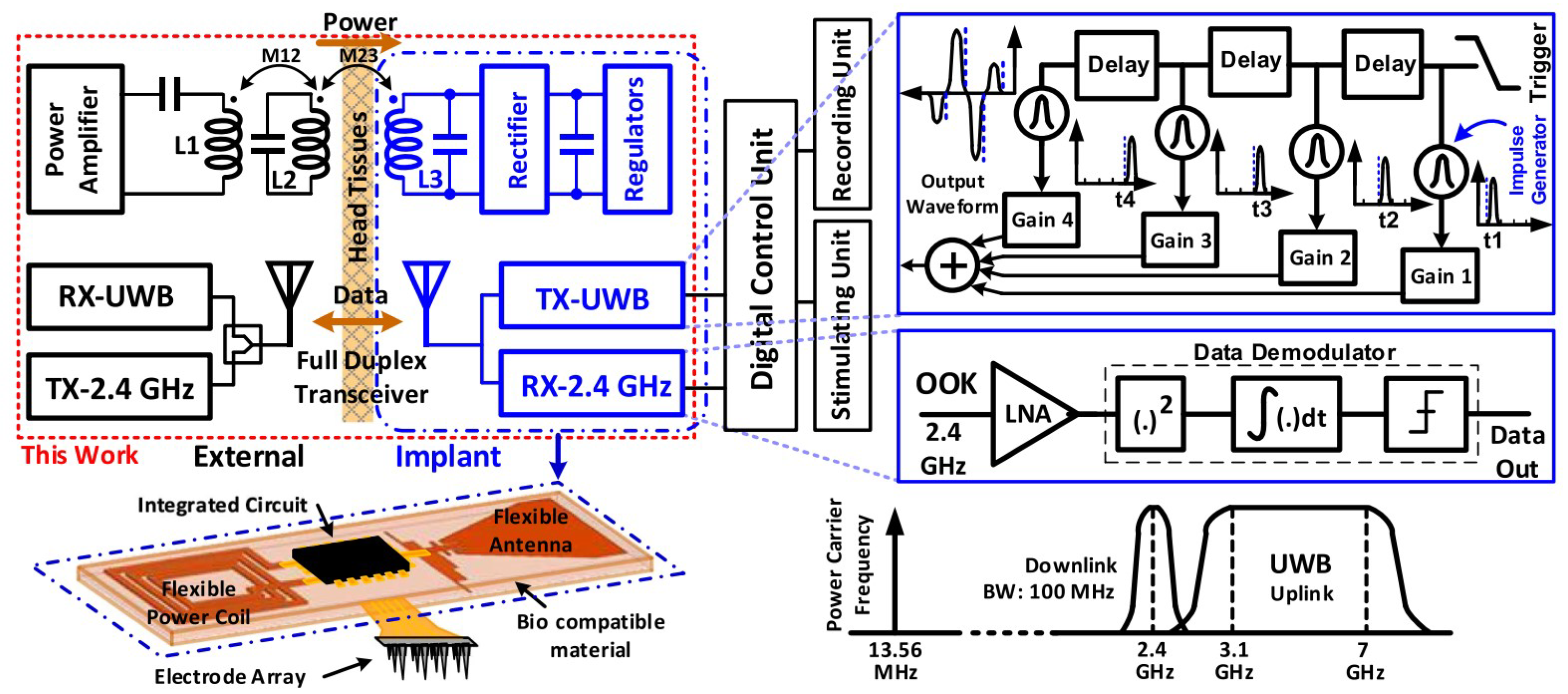




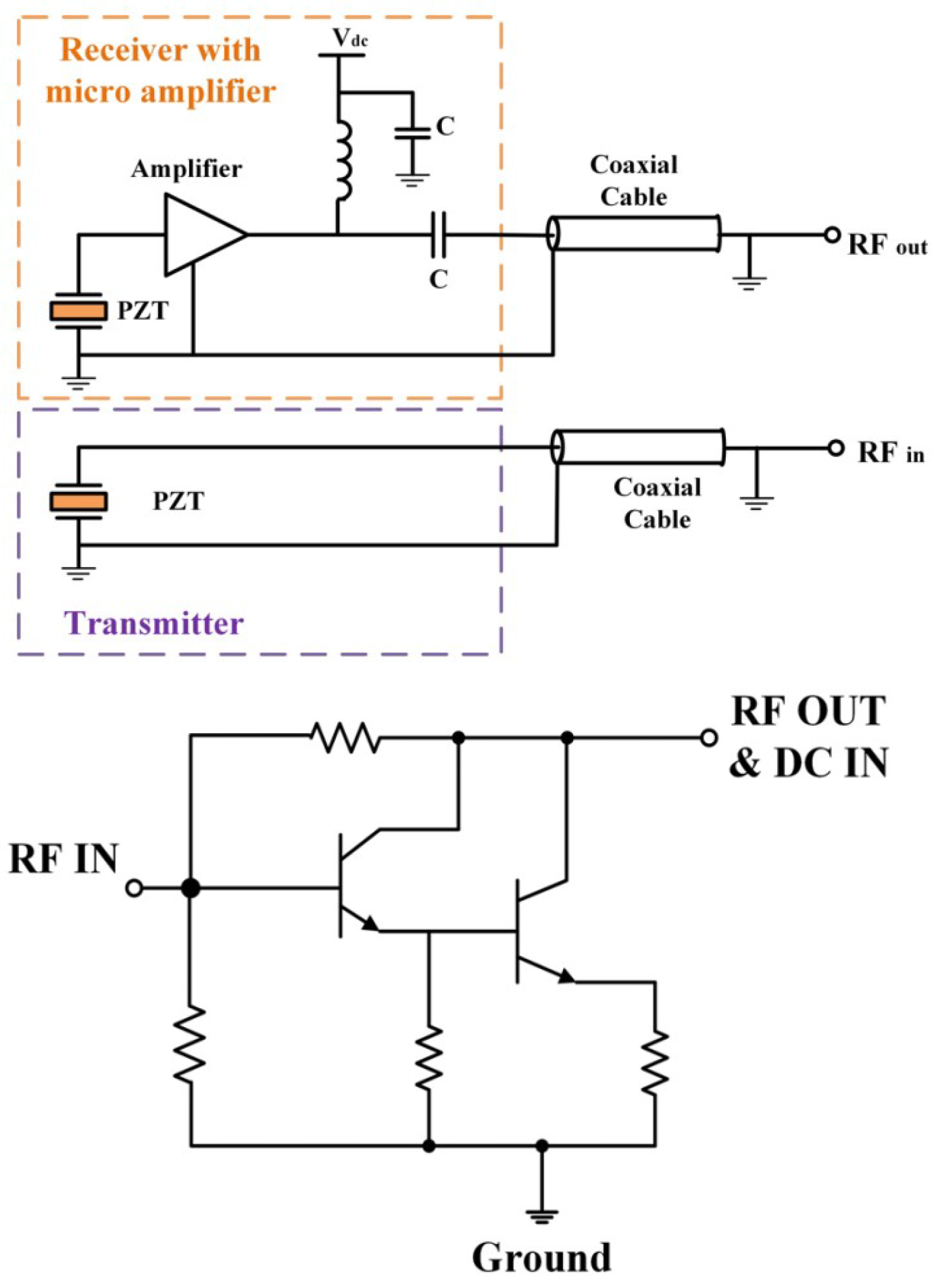


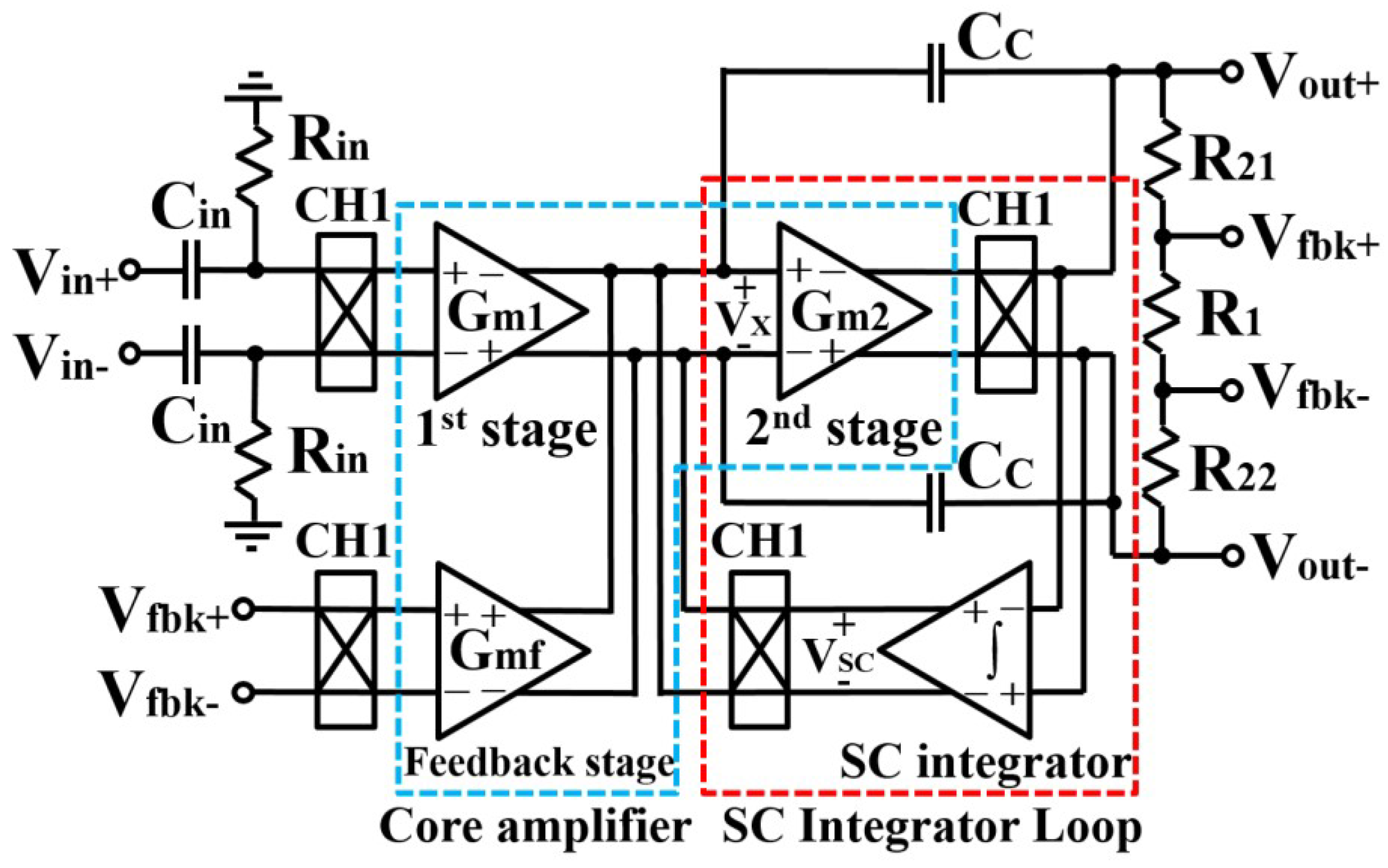

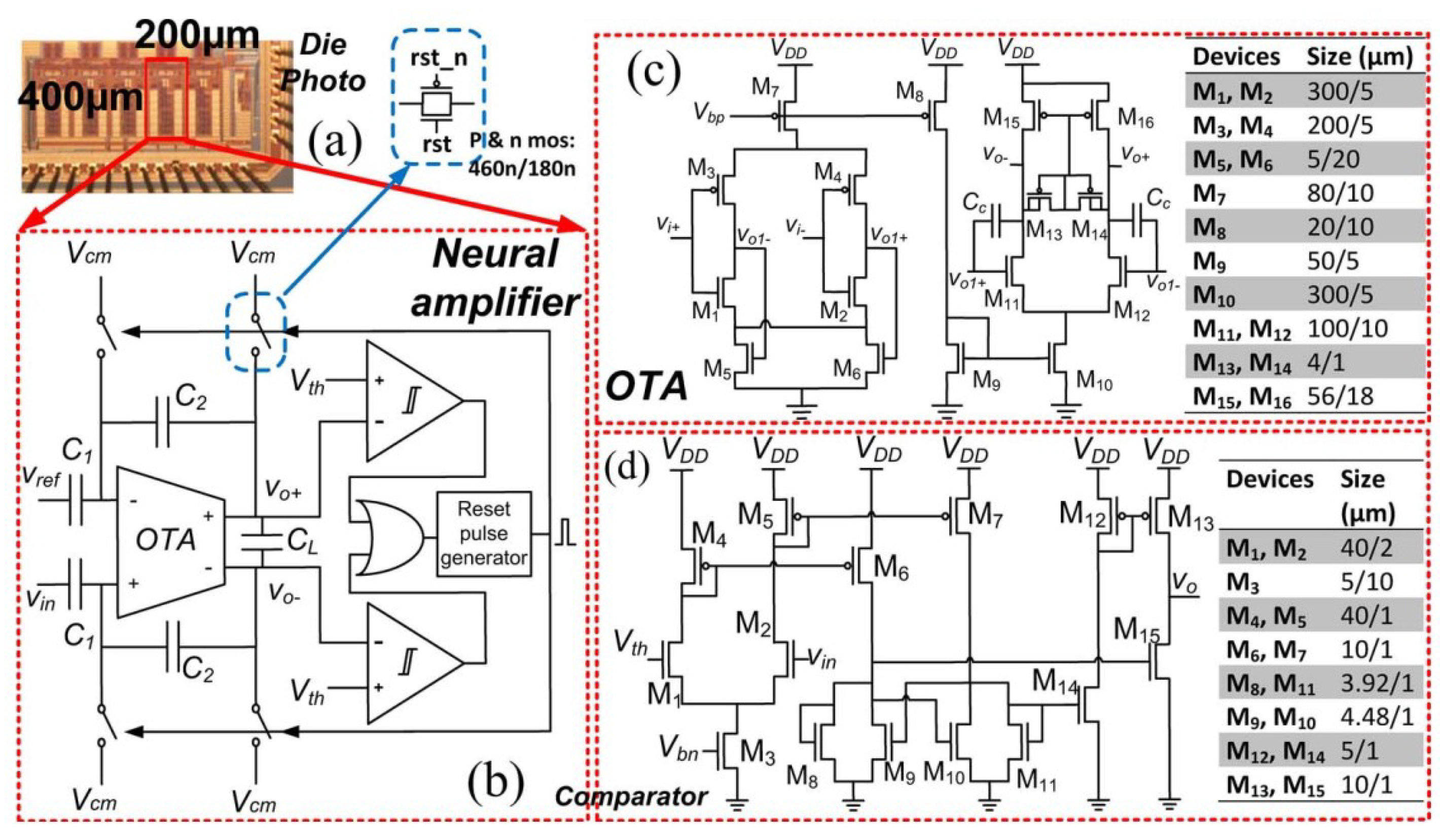

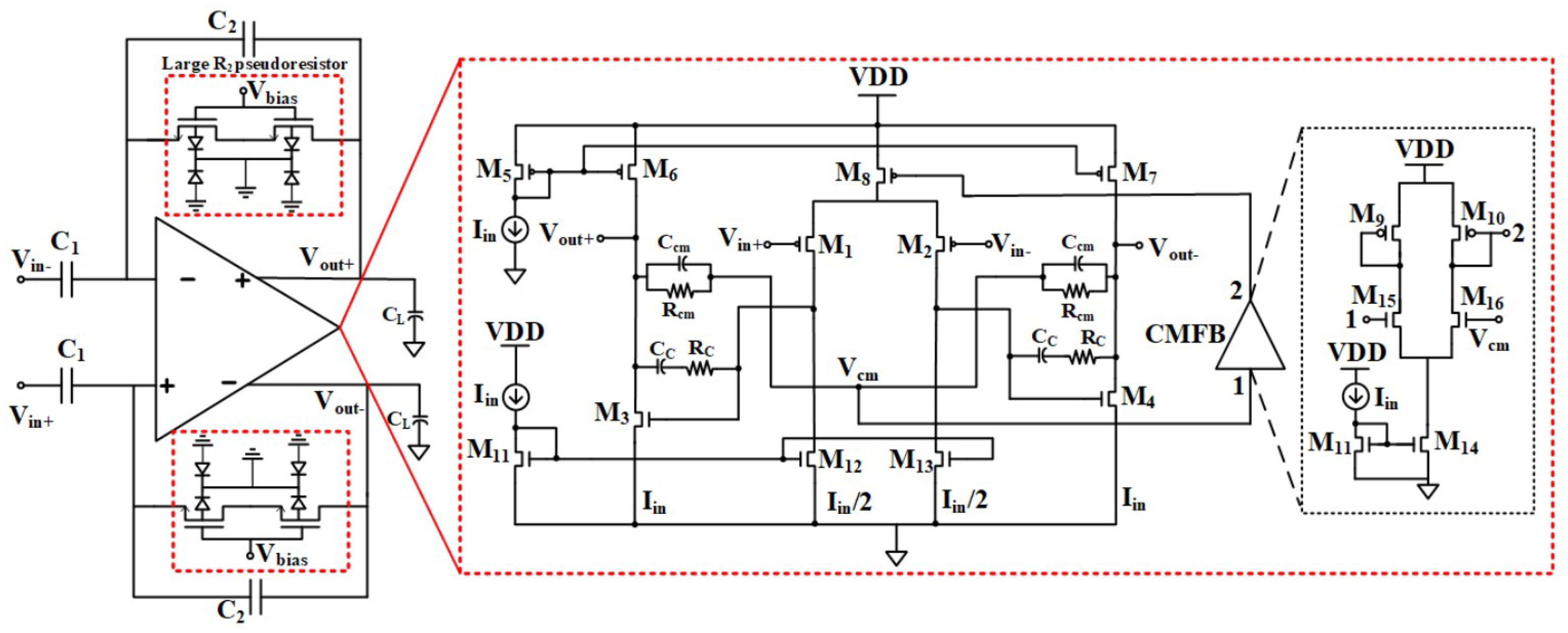

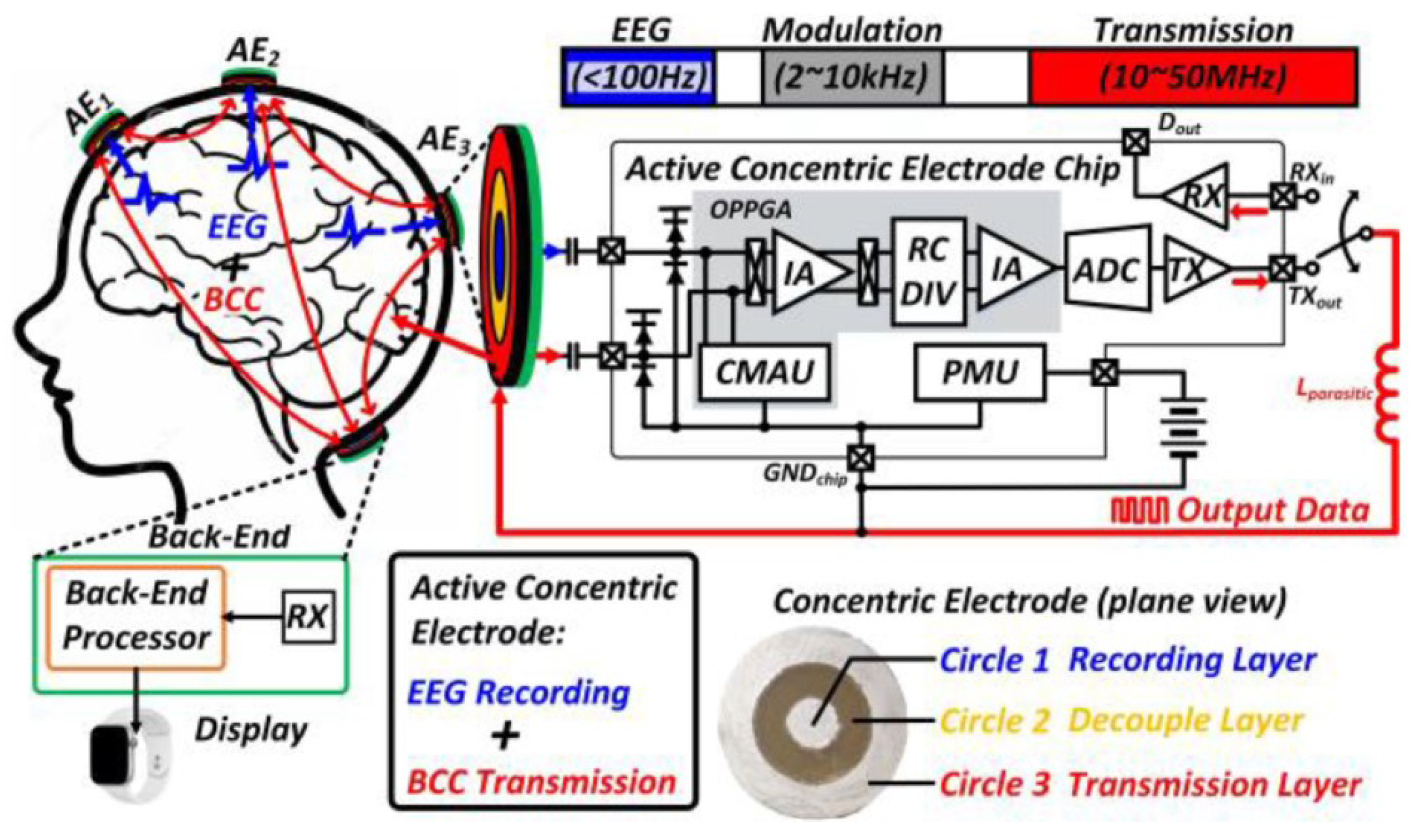
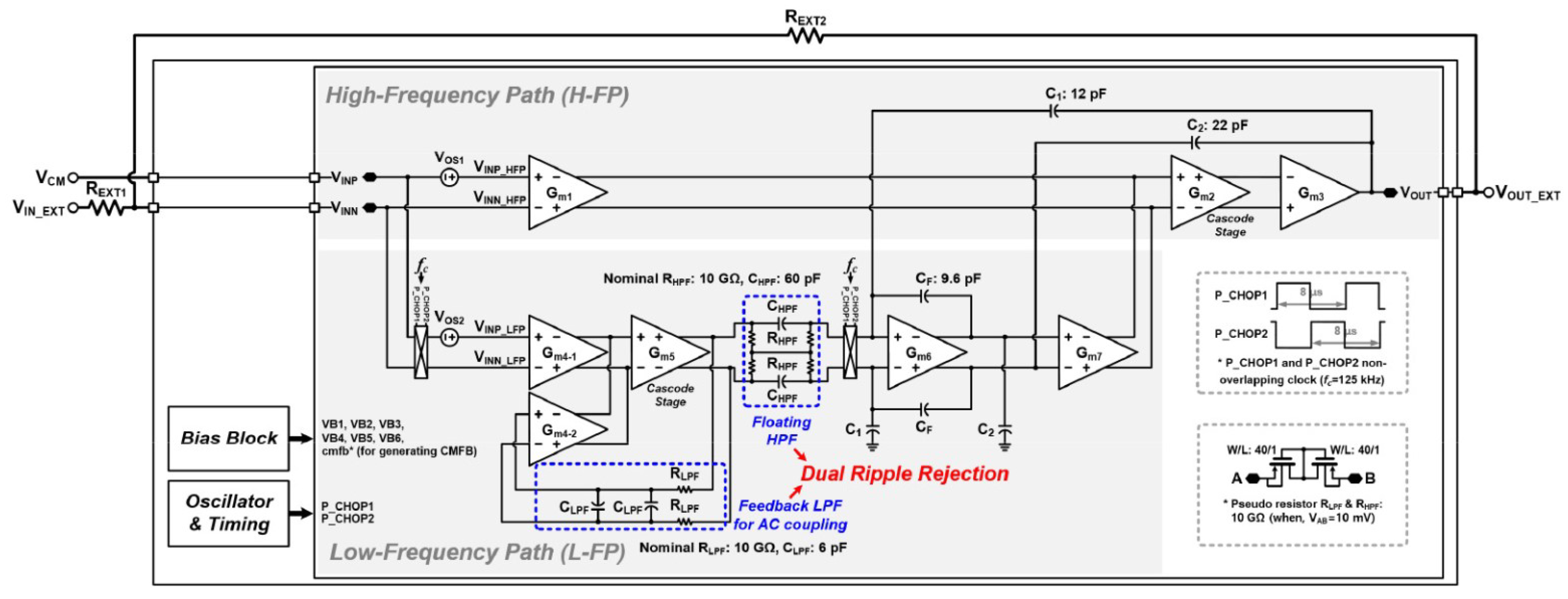




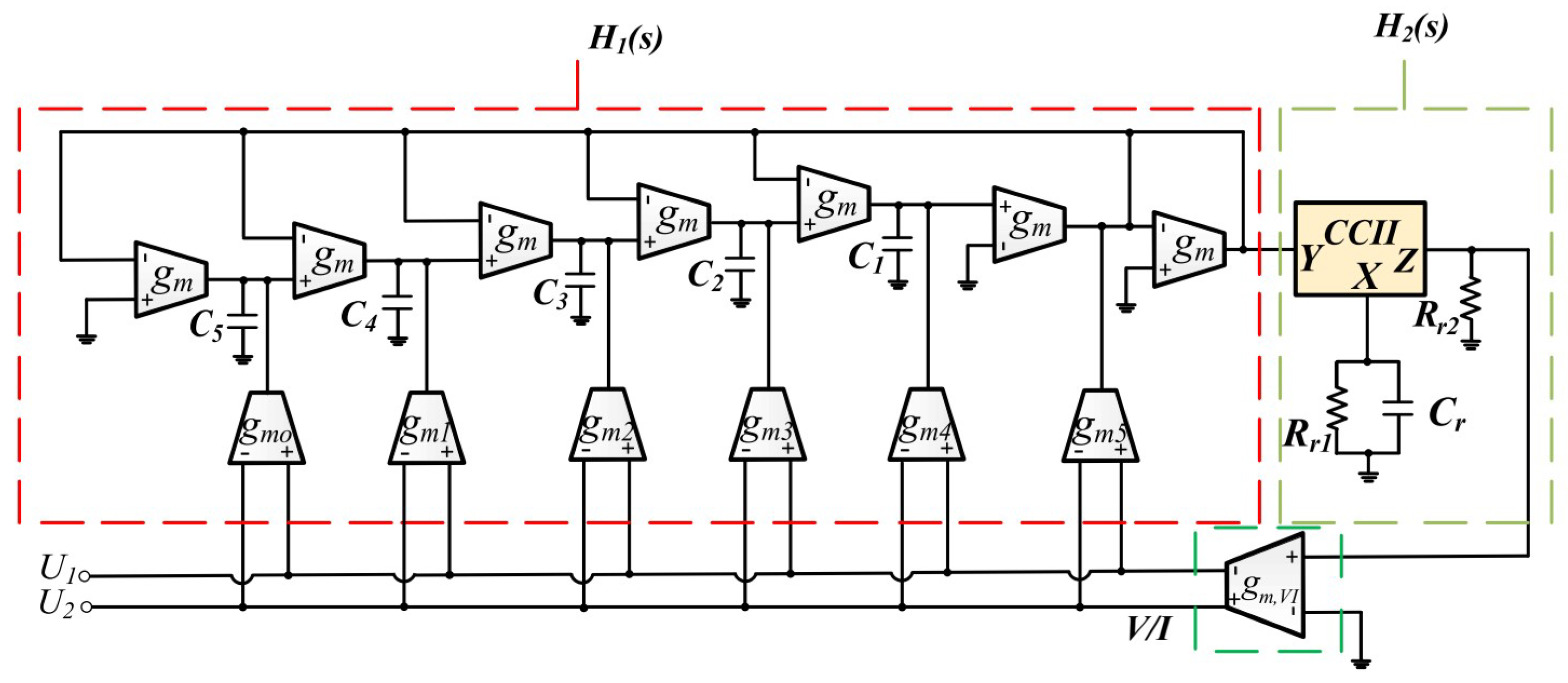
| Ref. | Scope | Contribution | Specifications |
|---|---|---|---|
| [1] | Provides wearable systems for monitoring health status. | Sensing the vital biosignals through a low-noise, energy efficient readout front-end. | Meeting the requirements of gain 45.94 dB, input referred noise of 0.184 µV, consumed power of 145.9 nW, and supply power of 1 V. |
| [21] | Provides two brain signal acquisition front-ends. | Providing low-noise amplifier arrays operating in a MOSFET weak inversion region. | Meeting the requirements of 0.216 µW with 0.4 V supply where the design is simulated in 180 nm CMOS technology. |
| [28] | Provides an eight-channel energy-efficient analog front-end for neural recording. | Improvements in power supply rejection ratio and dynamic range. | Meeting the requirements of 340 nW consumed power, 0.7 V supply voltage, input-referred noise is 6.7 µV, and the simulated environment is 65 nm CMOS technology. |
| [39] | Provides a fully-integrated low-power full-duplex transceiver. | Supporting high-density and bidirectional neural interfacing applications. | Meeting the requirements of 41.6% efficiency with power consumption of 10.4 mW when the design is simulated in 180 nm CMOS technology. |
| [40] | Provides a wireless and battery-less trimodal neural interface system-on-chip. | Supporting 16-channel neural recording, 8-channel electrical stimulation, and 16-channel optical stimulation. | Meeting the requirements of 55–70 dB for analog front-end with low/high cut-off frequencies of 1–100 Hz/10 kHz. |
| [42] | Provides brain–machine interface system. | Supporting Class-E/Fodd amplifier with a current-sense resistor. | Meeting the requirements of 54% efficiency at 309 MHz. |
| [44] | Provides a low-power transceiver for medical implant communication systems. | Includes wake-up signal reception, data-link binary frequency-shift keying reception, and transmission. | Meeting the requirements of a 97 dBm sensitivity with 2 mW power consumption that is simulated in 180 nm CMOS technology. |
| [44] | Provides a low-power transceiver for medical implant communication systems. | Includes wake-up signal reception, data-link binary frequency-shift keying reception, and transmission. | Meeting the requirements of a 97 dBm sensitivity with 2 mW power consumption that is simulated in 180 nm CMOS technology. |
| [48] | Provides an endoscopic transducer and is applied in medical ultrasound imaging. | Limiting endoscopic ultrasound detection depth. | Meeting the requirements of a 20 MHz center frequency. |
| [25] | Provides an in-ear brain–computer interface (BCI) controller system. | Includes a system-on-chip with electroencephalography readout and body channel communication. | Meeting the requirements of 82.9 µW power with 84% average accuracy. |
| [16] | Provides a cross-domain integration system. | Includes a gene transfer technique with a pre-clinical trial, an on-chip circuit design, an off-chip hardware with peripheral unit integration, and custom software. | Meeting the requirements of intermodulation distortion with a third order of approximately 68 dB with 16-bit output data. |
| [49] | Implements an amplifier for bio-potential signal acquisition applications. | Includes low-noise, low-power, chopper-stabilized, current-feedback specifications. | Meeting the requirements of input referred noise voltage of 0.75 µV at frequency band of 0.01–100 Hz, power dissipation of 2.3 µW, and a common-mode rejection ratio of 125 dB. |
| [34] | Implements Class-E amplifier for transferring data to medical implants. | Includes frequency-shift keying as a data modulation scheme. | Meeting the requirements of a power transfer efficiency of 25% and a power delivered to the load of 126 mW. |
| [50] | Presents a signal folding and reconstruction scheme for neural recording. | Includes 1/f characteristics of neural signals. | Achieves a gain of 54.2 dB, bandwidth of 5.7 kHz, and power dissipation of 2.52 µW. |
| [51] | Presents a front-end amplifier. | Includes 1/f characteristics of neural signals. | Achieves a power consumption of 7.6 µW with common-mode rejection ratio of 61 dB and the simulation platform is 180 nm CMOS technology. |
| [53] | Presents an electrocardiogram monitoring system. | Includes an on-chip integrated electrocardiogram signal acquisition system along with dry electrodes for wearable and long-term monitoring. | Achieves a gain of 43.09 dB and input-referred noise of 2.81 µV. |
| [54] | Presents a low-voltage current-reuse chopper-stabilized frontend amplifier. | Results in individual tuning of the noise in each measurement channel and minimizes the total power consumption. | Achieves a noise level of 0.34 µV with a power consumption of 1.17 µW. |
| [59] | Presents a chopper-stabilized low-noise multipath operational amplifier with dual ripple rejection loops. | Results in lower noise and a wider bandwidth. | Achieves total current consumption of 117.2 µA with 1.8 power supply, where the design is simulated in 180 nm CMOS technology. |
Disclaimer/Publisher’s Note: The statements, opinions and data contained in all publications are solely those of the individual author(s) and contributor(s) and not of MDPI and/or the editor(s). MDPI and/or the editor(s) disclaim responsibility for any injury to people or property resulting from any ideas, methods, instructions or products referred to in the content. |
© 2023 by the authors. Licensee MDPI, Basel, Switzerland. This article is an open access article distributed under the terms and conditions of the Creative Commons Attribution (CC BY) license (https://creativecommons.org/licenses/by/4.0/).
Share and Cite
Kouhalvandi, L.; Matekovits, L.; Peter, I. Amplifiers in Biomedical Engineering: A Review from Application Perspectives. Sensors 2023, 23, 2277. https://doi.org/10.3390/s23042277
Kouhalvandi L, Matekovits L, Peter I. Amplifiers in Biomedical Engineering: A Review from Application Perspectives. Sensors. 2023; 23(4):2277. https://doi.org/10.3390/s23042277
Chicago/Turabian StyleKouhalvandi, Lida, Ladislau Matekovits, and Ildiko Peter. 2023. "Amplifiers in Biomedical Engineering: A Review from Application Perspectives" Sensors 23, no. 4: 2277. https://doi.org/10.3390/s23042277
APA StyleKouhalvandi, L., Matekovits, L., & Peter, I. (2023). Amplifiers in Biomedical Engineering: A Review from Application Perspectives. Sensors, 23(4), 2277. https://doi.org/10.3390/s23042277










